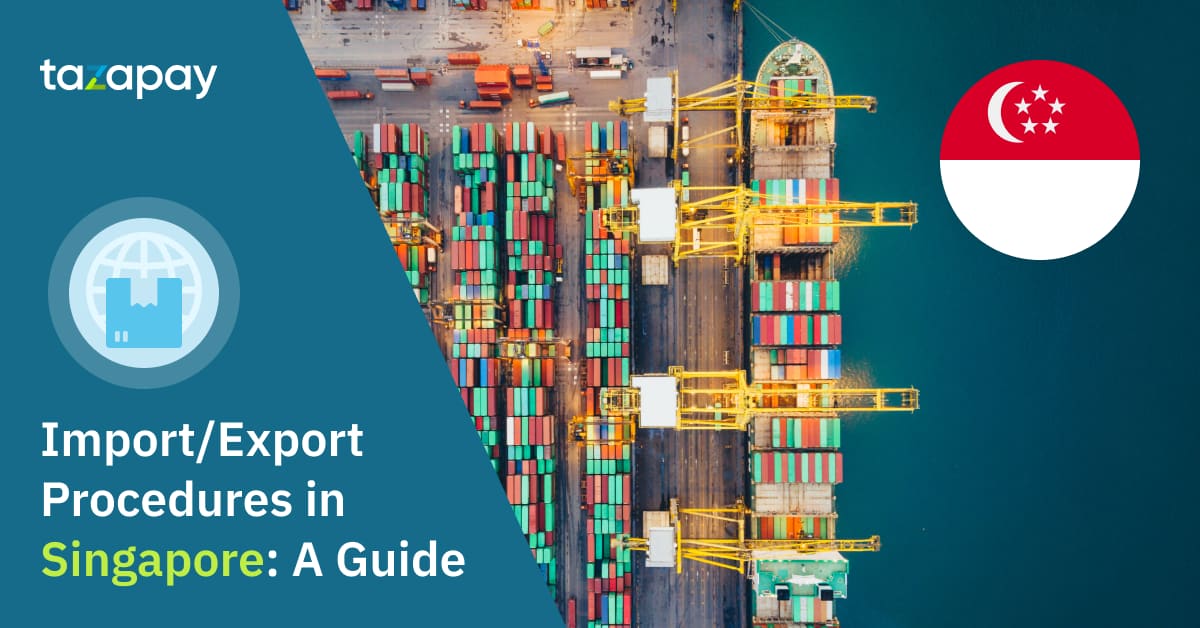- Home
Blog Blog
Export & Import Export & Import
Import/Export Procedures in Singapore: A Guide
Import/Export Procedures in Singapore: A Guide

Singapore is increasingly becoming popular amongst foreign traders owing to its comfort for doing business, a strategic location that connects the Western and Eastern shipping lanes, and global outlook. Singapore is well connected to 600 ports across 120 countries. Singapore boasts of being the world’s 2nd busiest container port and the #1 bunkering port and continued with the same valour even during the COVID-19 crisis. The exports from Singapore were valued at US$626 billion in 2020, being the second easiest country to do business with.

Singapore was also rated as the easiest country in the world to start, run and do business by the World Bank as incorporating a trading company to import and export takes only a few hours here. With its advanced infrastructure and clear import and export regulations, the import and export procedures are efficient & simple. Once you can acquire certain licenses and permits, you are good to go.
To import or export, certain documentation is required and the protocol set by the government needs to be adhered to, and you can have a business up and running in no time.
Guide for importing goods into Singapore
The imports of Singapore are governed by the Customs Act, Goods and Services Tax (GST) Act, and Regulation of Imports and Exports Act. The steps include:
Reviewing Controlled goods – Before you decide to import goods into Singapore, you need to verify if they fall into the controlled goods list or are restricted goods. Control goods require an additional permit from Competent Authorities (CA) before they are cleared for import.
Activation of the Customs Account – To start the import process, one must attain a Unique Entity Number (UEN). This can be done by registering with the UEN issuance agency or the Accounting and Corporate Regulatory Authority (ACRA). Once this is obtained, the importer can activate their Customs Account.
Registration for Inter-Bank GIRO Account – When one starts trading, you are required to pay duties, GST, and other fees, and to do this, the importer needs to have an Inter-Bank GIRO (IBG) account with the Singapore Customs. To start this account, one can submit the IBG form to Singapore Customs. Once the customs approves the application then one can start paying the relevant GST and other duties/ payments through this account.
Furnishing Security – An importer needs to provide some sort of security such as a bank guarantee or an insurance bond. This is required for importing dutiable goods, temporary import of goods for approved purposes, operating licensed premises such as warehouses and excise factories. The financial security will wary depending on the goods being imported and the trade movement.
Obtaining a Customs Import Permit – This can be done by submitting an application on the TradeNet system. To acquire this permit, the importer needs to get registered as a declaring agent or needs to appoint a declaring agent on its behalf.
Preparation of Documents for Cargo Clearance – These are required to be submitted to checkpoint officers at the time of cargo clearance at an entry point. Whether it is conventional cargo or containerized cargo, you should have a printed copy of the customs permit and other supporting documents such as the invoice, bill of lading, air waybill, the packing list, and more.
Ideally, one must have all documents physically or digitally associated with the import of goods for five years from the date of customs permit. These should be presented to Singapore Customs whenever requested.
Guide for exporting goods from Singapore
Export of goods in Singapore is controlled by the Customs Act, the Regulation of Imports and Exports Act, and the Strategic Goods (Control) Act. It is mandatory to declare all the goods being exported from Singapore even though they are exempted from GST and duty. If the exported goods are created in Singapore, a certificate of origin can be acquired online from the TradeNet platform.
Check if the export goods fall under the Controlled Goods category – Just like for an importer, an exporter also needs to confirm if the goods fall in the controlled category or are subject to restrictions based on the Singapore Customs classification database.
Activation of Customs Account – Just like a UEN is required for importing goods, a UEN will need to be obtained for export activities from ACRA or a UEN issuance agency. Once an exporter gets their UEN, they can activate the Customs Account.
Obtain Customs Export Permit – The customs export permit will be required for cargo clearance under certain scenarios such as exporting dutiable goods, exporting goods from bonded warehouses or re-exporting imported goods under the temporary import scheme.
Preparation of Documents for Cargo Clearance – If the exported good is dutiable or stated in the permit conditions list, then certain documents need to be produced for checkpoint officers at the point of cargo lodgement. In such occurrences, conventional and containerized cargo need the approved customs export permit and supporting documents such as bill of lading, invoice, packing list, airway bill, permit number, etc.
Just like import documents, all the pertinent export must be physically or digitally retained for five years from the customs permit approval date. There is a lot of similarity between the import and export procedures in Singapore, and being fairly simple, acts as catalysts for global trade.
Category

Export & Import
Import/Export Procedures in Singapore: A Guide
Related Articles

Why Do B2B Businesses Need Escrow Services

Problems Escrow Is Intended to Solve






